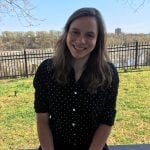Hannah Shaban leaves her audience with a gift. The first 86 visitors–the number of clay cups to survive the kiln–leave her VCU Graduate Candidacy Exhibition with full hands and a better understanding of what it means to be Arab American.
The opening night of Shaban’s exhibition at Artspace Richmond, she and her mother welcomed the guests trickling into the area as though they had been waiting for them all evening–sitting them down, feeding them a traditional Lebanese cake baked by her aunt, and gifting them with a hand-crafted Arabic coffee cup, plucked from the display on the wall.

Photo By: @hannah.shaban
It’s a performance piece, built as though you are stepping into their living room. At the beginning, the ceramic cups line the wall like an array of family photos, the display behind them yellowed with coffee, so even after they are taken down, their outline is unmistakable. By the end, the wall is empty.
“When you take a picture frame off the wall, it leaves a little bit of a halo. I was pushing for that,” said Shaban. “These cups are something I’ve cherished for a long time and I’m giving them to you. I wanted to fill their hands.”
Shaban is an MFA candidate at VCU with a focus on ceramic sculpture. As a first generation Lebanese American woman, most of her pieces wrestle with identity, with the Western misconceptions that pervade representations of Eastern culture.
“I couldn’t really ignore what was happening in the media and how Arabs are being represented, from 9/11 to the Syrian refugee crisis happening now. It’s this weirdly awful negative image that represents nothing about our true culture,” said Shaban.
Shaban spent this semester focused inward, on her grandmothers, on the hospitality and generosity that that defines her culture, “If you have something to give, you give it all.”

Photo By: @hannah.shaban
Counter to the American standards of generosity, nothing is ever expected in return. There is no bookend of apologies or bargains, it is a pay-it-forward ideology so that if someone is ever in need, they won’t even have to ask.
Shaban’s life-size, realistic sculpted figures insert the audience into the scene, using spatial and physical interaction to take viewers into the environment. It’s an immersion of sorts, created to shatter the stereotypical Western assumptions that inform their understanding of the Middle East. They are left with a gift, be it the hospitality and kindness of a stranger, or the beautiful delicacy of a cup.

Photo By: @hannah.shaban
“Every time people see [the cup], they will remember the act that my mother and I did, the act of giving away the cups, of welcoming them all in,” said Shaban.
The sculptures themselves are stunning, so realistic that walking into the gallery space almost feels like an invasion of privacy, an interruption of an intimate moment. Looking at them, it’s hard to believe that Shaban only discovered her gift for ceramic sculpture in her last semester of undergrad.
“I think of it as another language, as another way of translating my life,” said Shaban. “I feel like in my head I’m constantly jumping between Arabic and English, between my American identity and my Arab identity, and clay comes in as another language of mine, another thing that I’m translating myself in and out of.”
As a first-generation American, Shaban said she is constantly forced to address the same question: “Where better?” In fact, it’s the central theme of one of her recent installations, an eight-and-a-half-foot tall rock wall, based off the retaining wall holding off the hill behind her grandparents’ house in Ammatour, Lebanon. It’s the place where relatives and people of the village come to greet her when she visits every summer, and ask, ‘Wayn ahla, Amerca ow Libnan?’ meaning, ‘Where do you like more, America or Lebanon?’

Photo By: @hannah.shaban
“We all are missing something here. There’s a popping back and forth between cultures,” said Shaban. It is a constant pressure to choose between two worlds, as though the cultures can’t exist in tandem.
It doesn’t help that Western culture has divided the Middle East into a series of stereotypes, with their only redeeming quality being beautiful women and hummus–that Americans are then defiling with avocado.
She spoke about the first images of the Middle East created by French Orientalist painters, who created the initial allure of Arab culture: beautiful possessed women, silks, architecture, and men with beards and curved swords. A series of stereotypes: beautiful, but cliched.
“I wanted to take my modern Arab subjects and layer them with this orientalist design–like things that were originally so seductive, I wanted to take that old seduction and put it on my modern subjects,” said Shaban. “Lure people in with the beauty, have them stick around for the substance.”
Though there is an inherent politicism surrounding the Middle East, Shaban’s focus on social and cultural elements means she deals more with addressing the harmful cliches than the complex political landscape surrounding American foreign politics. Though she tried to push away from her focus on identity, feeling pressured to tackle the “big stuff” like the Syrian refugee crisis, it felt less authentic in her work.

Photo Courtesy of Artspace Richmond
“It wasn’t my story, I felt like I was almost cheating using them,” said Shaban. “What connection do I really have with Syrians being displaced from their homes, why did I feel like I could use their story in art?”
Instead, she turned again to the universality of identity, questions of who you are, and where you belong. Shaban is repairing the small damages, that in summation prove no less harmful. American misunderstanding and ignorance of the Middle East attempts to define a culture they don’t even understand, and Shaban’s work welcomes them into their ignorance, shows them hospitality and kindness, and then–sometimes–leaves them with a cup.
TOp Photo By: @hannah.shaban



